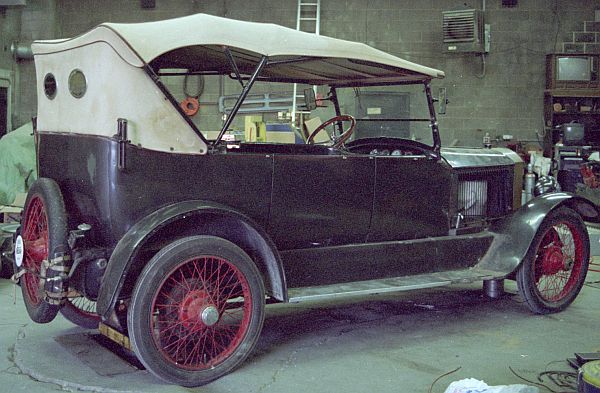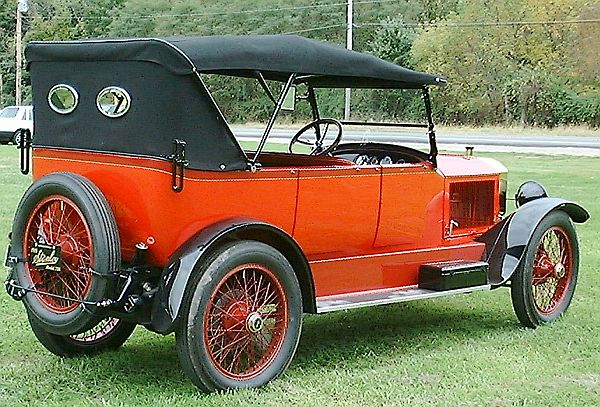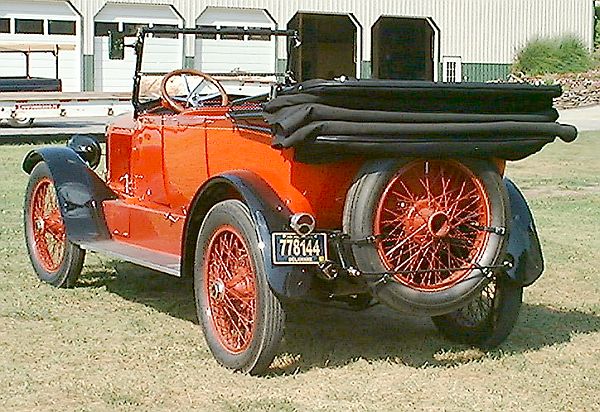|
Anytime the car had been photographed while Marvin Klair owned it those photographs always showed the car's top raised. Marvin mentioned some time after the purchase that from 1964 when he purchased the car until 1997 when he sold it that the top had only ever been down once. His follow-up comment was that the top was just too difficult to keep putting up and down. It wasn't until partway through the installation of the replacement top bows that a possible explanation for the difficulty in operating the top became apparent.
The car arrived on January 1, 1998 at the home of the new owner's brother's shop. January 2nd saw the car undergoing a complete cleaning inside of assorted fruits and nuts from the years of animal inhabitation along with a lot of photographs such as the one above documenting the car's condition. As January 3rd and 4th were going to be unseasonably warm days (mid-60s for northern Delaware) it was decided that it would be a good opportunity to steam clean the underside of the car to rid it of years of accumulated steam cylinder oil and dirt. A light tan canvas top however would become soiled with the splashing of water, oil, and dirt from the steam cleaning so lowering the top and covering it with plastic for protection was the solution. Unfortunately when the top was lowered the canvas didn't fold as expected, it remained stiff and ended up cracking like sheets of heavily starched cloth. The rubber interior laminate of the top material had become brittle and when folding of the canvas was attempted the rubberized cloth cracked like glass. The dry-rotted canvas had little strength left and it simply tore and split. Needless to say the top instantly became useless except as a template for making the replacement top. So, three days after purchase a razor blade was taken to the top across the rear of the car at the metal body line so that the top could be removed. The two top bow socket pivot nuts were removed and the top, bow and sockets included, was removed from the car, folded, and stored for later restoration. The car would not have a top until the late fall of 2005.
The photograph above is of the Stanley with the new top recently installed in October 2005. The car had just been out for a drive; the first time to be driven with the new top in place. The change back to black was in keeping with the way Stanley cars left the factory. Most likely a 1918 Stanley would have had a canvas top which is actually a canvas, rubber, canvas composition. Later Stanleys would use a coated canvas top material giving a smoother look. There are mixed feelings about the use of a top on a Stanley. A top provides excellent shade when driving in the hot summer sun. The down side to having the top up is that it really restricts visibility. Stanleys never had rear view mirrors at the center top of the windshield as today's cars do. A driver's side mirror was optional equipment and with the mirror's position and the size of the car the driver's rear view mirror isn't always useful. Many think a Stanley looks better with the top up however perhaps just as many think the car looks better with the top stowed. With a top rising up just over seven feet from the pavement car needs to be exercised when the top is up that a low branch or even a garage opening is high enough to clear the "top" of the car.
The Stanley sales literature for 1918 advertised the "new and improved one-man top". The 1918 top design was perhaps simpler than that employed in pervious years however it was far from being a "one-man" top. By "one-man" the intent was that a single person could raise or lower the top. It can be done but the odds of getting the top either up or down without damaging the top and/or the body finish isn't that likely. The easiest way to raise or lower the top is with two people. Simply undoing the clamps at the windshield posts and grabbing the top bow socket frame in the middle of the car and lowering the top to the stowed position shown in the above photograph is not only the safest but the simplest to do. Getting the top down is easy because the weight of the top is assisted by gravity. It is unknown if Stanley offered a "California Top" in 1918 which is a top that is "hard" and can not be raised or lowered. Raising the top is a bit more of a chore since it has to be pulled up into position. Once the top is up the side curtains can be installed if necessary. A boot covers the top when it is down and stowed and provides protection. |



